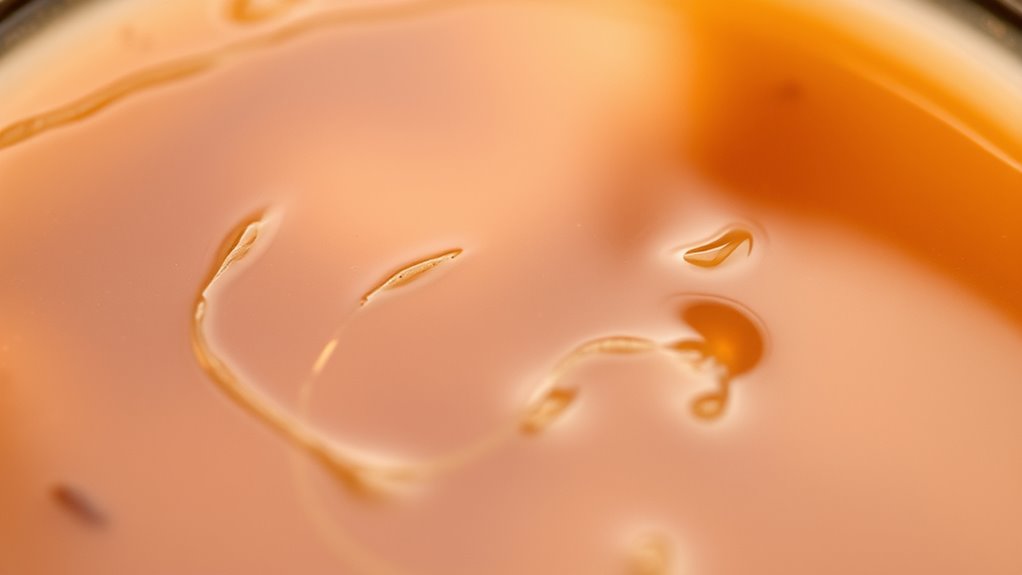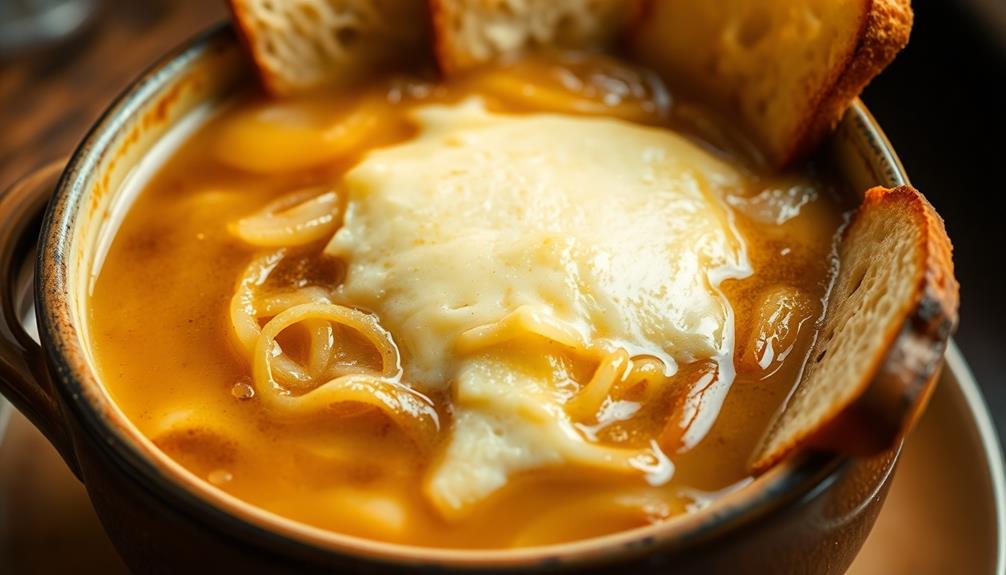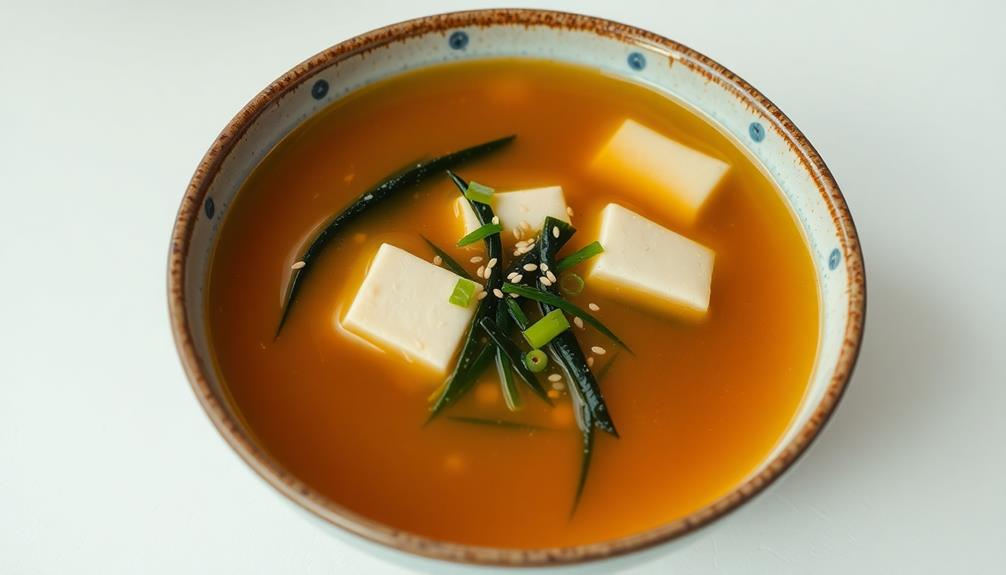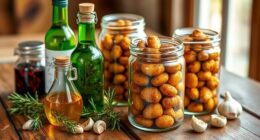When you simmer bones, collagen naturally breaks down into gelatin, giving your broth its characteristic gel-like texture. This process happens because heat denatures collagen fibers, hydrolyzing them into soluble gelatin. The more you simmer, the more collagen converts, thickening the broth and boosting its nutritional value with amino acids like glycine and proline. To learn about how different collagen types influence this gelification, keep exploring the details behind this fascinating transformation.
Key Takeaways
- Collagen in bones and connective tissues breaks down into gelatin during slow simmering, creating the broth’s gel-like consistency.
- Types I, II, and III collagen influence gelatin formation, affecting both texture and nutritional benefits of the broth.
- Longer simmering increases collagen hydrolysis, extracting more gelatin and resulting in a thicker, more gelled broth.
- Gelatin’s soluble proteins help form the broth’s characteristic gel when cooled, indicating effective collagen extraction.
- Understanding collagen’s role allows for optimized cooking to enhance broth’s texture and health-promoting properties.
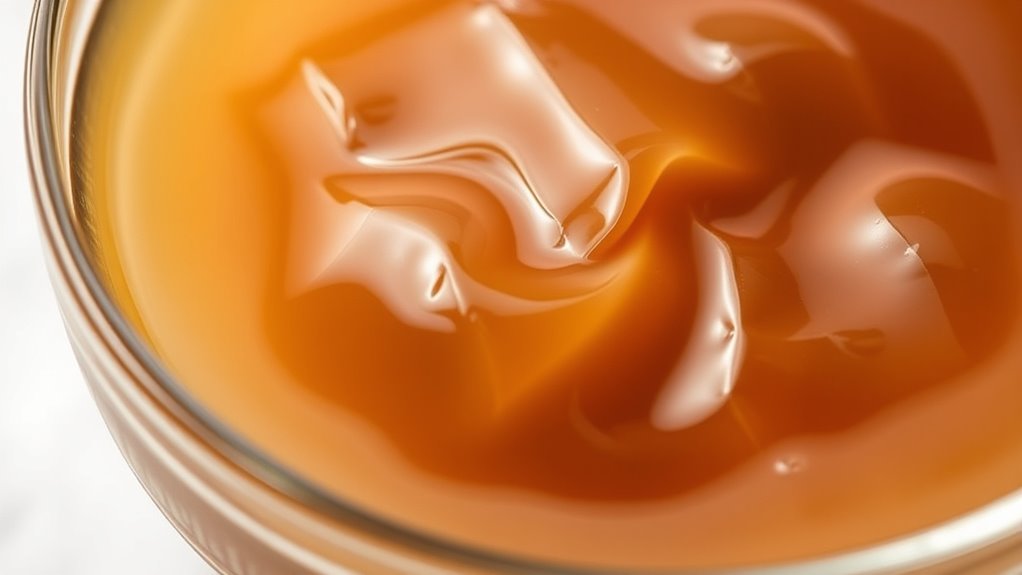
If you’ve ever enjoyed a bowl of rich, jiggly bone broth, you’ve experienced the gel-like texture that comes from its high collagen content. This unique consistency results from the process of gelatin extraction, which occurs when collagen breaks down during slow simmering. Collagen is a crucial structural protein found abundantly in bones, cartilage, and connective tissues. When you simmer these parts, heat causes collagen to hydrolyze into gelatin, a soluble protein that creates that desirable gel when cooled. Understanding how different collagen types contribute to this process can deepen your appreciation for bone broth’s benefits and texture.
Collagen isn’t just one uniform protein; it comprises several types, each with specific roles and distributions in the body. Types I, II, and III are most relevant in the context of bone broth. Type I collagen, the most prevalent, is found in skin, tendons, and bones. When it breaks down during cooking, it forms gelatin, which gives bone broth its characteristic jelliness. Type II collagen, primarily present in cartilage, also contributes to the gelatinization process, especially when cartilage-rich bones like knuckles or joints are used. Type III collagen, often found alongside Type I, supports the structure of skin and blood vessels, and its presence in bone broth enhances both nutritional value and gel strength. Additionally, the presence of other collagen types can influence the broth’s overall health benefits and texture. Understanding collagen types can help you better tailor your cooking process to optimize both nutritional content and desired consistency.
Types I, II, and III collagen influence gelatin formation and broth gel strength.
The process of gelatin extraction hinges on careful simmering, typically over several hours. During this time, heat causes collagen fibers to denature and release gelatin into the liquid. The longer you simmer, the more collagen converts into gelatin, resulting in a thicker, more gel-like broth once cooled. This transformation is essential for the broth’s texture but also preserves the collagen’s nutritional qualities, including amino acids like glycine and proline, which support joint and skin health. Recognizing the importance of collagen types can help you tailor your cooking process to achieve specific textures and nutritional outcomes, making your broth more personalized and beneficial.
Frequently Asked Questions
Can Plant-Based Sources Replace Collagen’s Gelification Properties?
You wonder if plant-based alternatives can replace collagen’s gelification properties. While plant-based gelification substitutes like agar-agar, carrageenan, and chia seeds can mimic gel formation, they don’t perfectly replicate collagen’s unique ability to create a firm, elastic gel in bone broth. These substitutes work well in vegan recipes, but if you’re aiming for the same texture as collagen-based gelification, you might need to experiment with different plant-based options to achieve your desired consistency.
How Does Aging Affect Collagen’s Ability to Gel in Bone Broth?
As you age, collagen’s gentle dance within your body slows down, subtly affecting its gel-forming abilities. Increased collagen crosslinking makes the protein strands less flexible, while decreased enzymatic activity hampers new collagen production. This means your bone broth may not gel as firmly, reflecting these natural changes. You might notice a softer set, but with mindful nutrition, you can support your body’s ongoing collagen needs, even as time passes.
Are There Specific Cooking Methods That Enhance Collagen Gelation?
To enhance collagen gelation in your bone broth, focus on specific cooking techniques like slow simmering and longer cooking times. These methods help break down collagen into gelatin, improving gelation. Adding acidic ingredients such as vinegar or lemon juice can also boost gelation enhancement. Keep the heat low and cook for at least 12-24 hours to maximize collagen extraction, resulting in a richer, more gel-like broth.
What Role Do Minerals Play in Collagen’s Gel Formation?
Minerals play a vital role in collagen’s gel formation by influencing mineral interactions that impact gel strength. When minerals like calcium and magnesium bind with collagen, they help stabilize the gel network, making it firmer and more cohesive. You’ll notice that a well-mineralized broth results in a stronger, more desirable gel, as these minerals enhance collagen’s natural gelling properties and contribute considerably to the overall texture.
How Long Does Collagen Take to Fully Gel in Bone Broth?
It’s interesting how gelation timing varies, often coinciding with collagen maturation. Usually, you’ll notice the broth starts to gel within 12-24 hours after cooling, but full collagen gel formation can take up to 48 hours or more. Factors like temperature, pH, and the amount of collagen influence this process. So, patience is key—your bone broth will reach that perfect gel point as collagen fully matures.
Conclusion
Now that you know how collagen works in bone broth gelification, you can see it’s like a glue holding everything together. When you heat and cool the broth, collagen transforms into a gel, giving your broth that perfect, silky texture. So, next time you make bone broth, remember it’s not just about flavor—it’s about harnessing collagen’s magic to create that delightful, jiggly consistency you love. Embrace the science, and your broth will always turn out just right!
